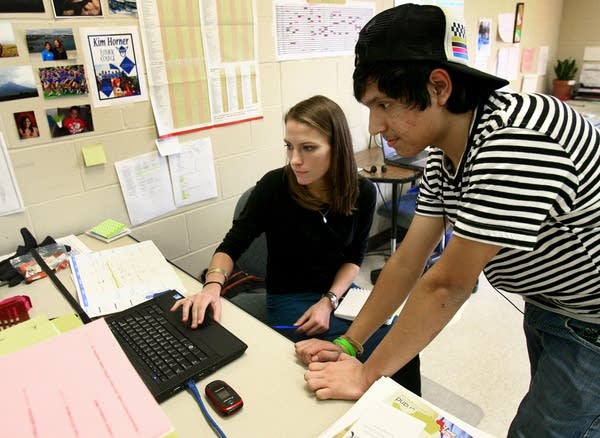Northfield program shrinks Latino achievement gap
Go Deeper.
Create an account or log in to save stories.
Like this?
Thanks for liking this story! We have added it to a list of your favorite stories.

When Jhosi Martinez thinks of college, she remembers the words of her father.
"He's always wanted me to graduate and he's always wanted me to continue and go to college and become someone else," the Northfield High School senior said.
Jhosi's dad never graduated from high school. Neither did her mom nor her older sister. Her family is like that of tens of thousands of Mexicans who have moved to greater Minnesota in search of better opportunities.
Turn Up Your Support
MPR News helps you turn down the noise and build shared understanding. Turn up your support for this public resource and keep trusted journalism accessible to all.
Many of those families represent a persistent achievement gap between white students and students of color that Minnesota education have long grappled with.
But in Northfield, that gap has practically vanished in the past decade, because of a program committed to getting the district's growing Latino student population to graduate from high school.
So Jhosi Martinez, 18, turned to the program known as TORCH -- Tackling Obstacles and Raising College Hopes.

On a recent day in a computer lab at Northfield High, she scrolled through the fields of an online college application.
"Right now, I am applying at Bemidji (State University) and I'm just going through the application process and filling it out," she said as a volunteer helped her navigate the online form. Within minutes, the application was complete.
In the past year, volunteers have also helped Jhosi keep her grades up with one-on-one tutoring and mentoring.
"Whenever we need help with anything, they help. If you have a question with a math problem and you want someone to review your essay for English class or anything like that, they always help out," she said.
Had Jhosi grown up in Northfield a decade ago, her chances of going to college would have been slim. From 2001 to 2005, only 36 percent of Latino students graduated from high school. Teachers and parents became concerned.
"We had a sense that many of them were dropping out to go to work because of the promise of the dollar."
"We had a sense that many of them were dropping out to go to work because of the promise of the dollar," said Beth Berry, coordinator of the Northfield program.
The idea for the program started when a group of teachers applied for a $1,500 grant to start the program and organized a dinner for the Latino community.
"We held it at a bowling alley so families had dinner and kids went bowling while we talked to the parents about the promise of larger dollars with more education and that in the U.S. it really is not an option not to graduate from high school," Berry said. "We really had terrific buy-in in part of the parents."
The TORCH program born from that dinner is independent of the school district but housed inside the high school. It relies on $100,000 in grants to cover Berry's salary, as well her counterpart at the middle school.
The program tracks students through high school and during their college years, offering after-school tutoring, home visits and in some cases financial aid. It also takes families on college tours each spring.

"The parents actually see where the students may be, and that's been a tremendous payoff, too, because once parents are on a campus and begin to feel that there is a lot of potential and a lot of support for their child, they've generally been very encouraging and very positive," Berry said.
TORCH currently serves about 350 students, including 50 in college. This year, all of Northfield High School's Latino students graduated. In all, 49 TORCH alumni have gone on to receive a two-year certificate program or college degree.
Part of the credit for that success goes to the program's location and Northfield's culture of education. The city is home to two liberal arts colleges, St. Olaf College and Carleton College, which offer a steady stream of college student volunteers to mentor and tutor many of these first-generation, low-income students.
Adrienne Falcon, director of civic engagement at the Carleton's Center for Community and Civic Engagement thinks the TORCH program can be a model for communities across Minnesota struggling with their own changing demographics.
"Each community has to build from their place of strength," Falcon said. "But I think the idea of connecting students to college campuses, connecting students to college students and in meaningful relationships of deep exchange is a model that is very replicable.
"It's about finding, 'Where else can we go? Who else can we collaborate with? Up in Duluth, could St. Scholastica take this one?'"
That's already happening 20 minutes south of Northfield, in Faribault.
The high school started a similar program last year, focused on the community's growing East African and Latino populations.
In its first year, the Faribault program graduated 13 of 22 minority seniors, better than in previous years, said Martha Schultz, program coordinator.
"We understand that what we're facing in Faribault is different than what Northfield is facing," Schultz said. "We don't have the same resources. We have a different student population. But we still understand that Northfield's main components of TORCH, like building relationships, building trust in the community and building this spirit of wanting to go to college was successful and so we're taking those components and bringing them to Faribault."
Frank Calvario is another Northfield senior who credited TORCH with improving his grades and understand the college process. He's applied to several universities, including National University in California, hoping to work in the digital design industry.
"It's awesome," Calvario said. "It gives Hispanic students that sense of having control of what they're going to do with their lives afterwards."




